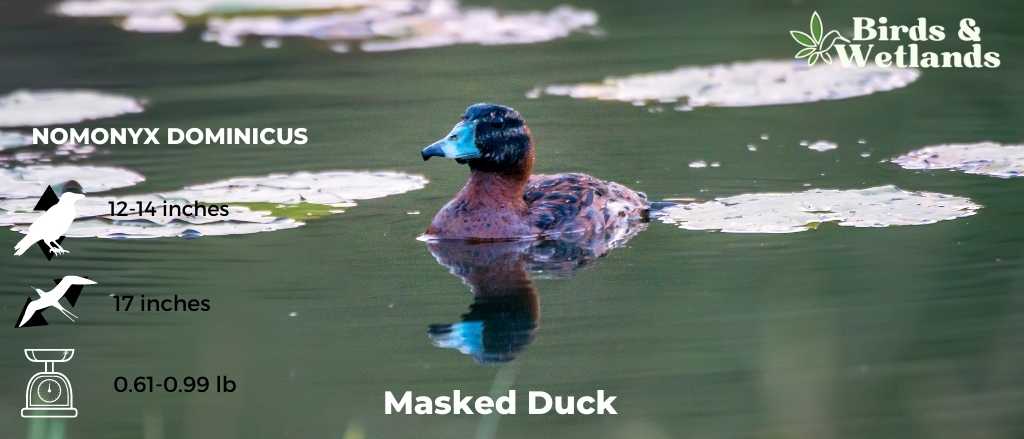
The masked duck is a small, stocky waterbird found in the wetlands and swamps of Central and South America. Its scientific name, Nomonyx dominicus, refers to its secretive nature and distribution in the American tropics.
The masked duck is a shy and elusive bird often found in small groups or pairs, hiding among the reeds and vegetation.
The population of the masked duck is believed to be stable, although it needs to be better studied, and little is known about its population size and trends.
Scientific Name: Nomonyx dominicus
Family: Anatidae
Length: 12- 14 inches
Wingspan: 17 in (43 cm)
Weight: 9.7-15.8 oz (275-450 g)
Physical Description
The adult male in breeding plumage is a striking and distinctive bird with a black face mask that covers its eyes and bill. Its bright blue bill is topped with a black nail, giving it a sharp and prominent appearance.
The bird’s dark eyes are surrounded by bright eyering, adding to its dramatic and bold look. Its body is a rufous-brown color, speckled with black feathers that add texture and depth to its plumage.
The adult female has a barred, rufous-brown, gray body that is elegantly proportioned. Its face is adorned with two horizontal, dark-colored stripes that stand out against the buff-colored feathers, adding a touch of drama to its appearance.
The duck’s bill is black and strong, while its wings and tail are blackish, with a small patch of white on the wings.
Listen to the Masked Duck
Habitat
The masked duck is a shy, reclusive bird typically found in forested wetlands with open water, marshy ponds with dense marshy vegetation, and shallow freshwater bodies like roadside ditches. These habitats provide the necessary cover and concealment for the masked duck to feel safe and secure.
In addition to these habitats, masked ducks are found in mangroves, rice fields, and swamps. These areas offer the bird a rich diversity of food sources and ample opportunities to forage and hunt for insects, seeds, and other small prey.
These ducks colonize small and temporary bodies of water while searching for a suitable habitat.
Range
Breeding populations are dispersed throughout the eastern regions of Central and South America. Masked ducks occur in Mexico, the Caribbean, Peru, eastern parts of the Andes, Brazil and northeastern Argentina.
As one of the ducks of North America, masked ducks are commonly found with ruddy ducks in southern Texas, Arizona, Florida and New Mexico. Some sightings of masked ducks have been documented as far north as Wisconsin, Massachusetts and Pennsylvania.
Feeding Habits & Diet
The masked duck’s diet consists primarily of aquatic vegetation, seeds, tubers, roots, sedges and grasses.
In addition to these plant-based foods, the masked duck will occasionally feed on invertebrates, aquatic insects, crustaceans, and small fish.
The masked duck feeds by diving under shallow water, using its strong legs and webbed feet to search for food on the bottom of lakes, ponds, and other bodies of water. These birds are not particularly active during the day and tend to feed at night, making them somewhat elusive to observe.
Nesting & Mating Habits
Unlike migratory ducks, masked ducks breed all year round throughout their range. The peak breeding season depends on their location. During this time, males perform elaborate courtship displays including emitting soft calls and short rushes across the water’s surface.
These birds nests in pairs and very rarely in loose colonies with other stifftails. The nest site is close to the water, usually hidden among emergent vegetation and surrounded by heavy tree cover. The nest is a woven bowl on the ground, made from the soft plant material with sparse lining of down feathers.
The female lays 3 to 6 creamy-white eggs, which she incubates alone for 25 to 30 days. It is not uncommon for multiple females to lay eggs in a single nest, resulting in a larger clutch.
Threats & Conservation
The masked duck is listed as a species of “Least Concern” by the International Union for Conservation of Nature (IUCN). This means that it is not currently considered at risk of extinction.
However, like many wetland birds, this duck faces several threats, including habitat loss and degradation due to the conversion of wetlands to other land uses, such as agriculture, urban development, and resource extraction.
Key Points
- In south Texas, this stiff-tail duck is often found with its close relative, the ruddy duck.
- It breeds in wetlands with marsh vegetation.
- It is a widespread duck in South and Central America.

